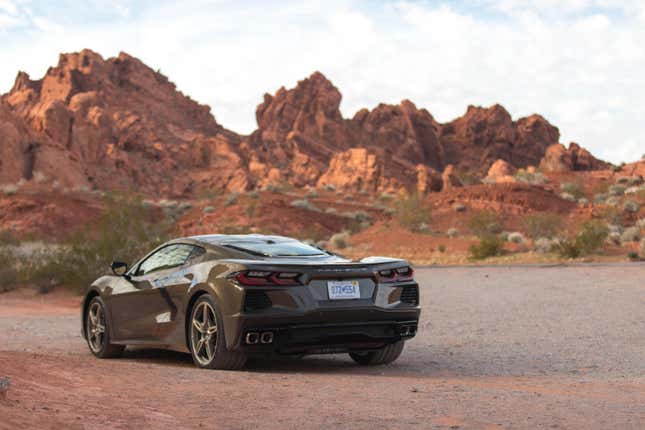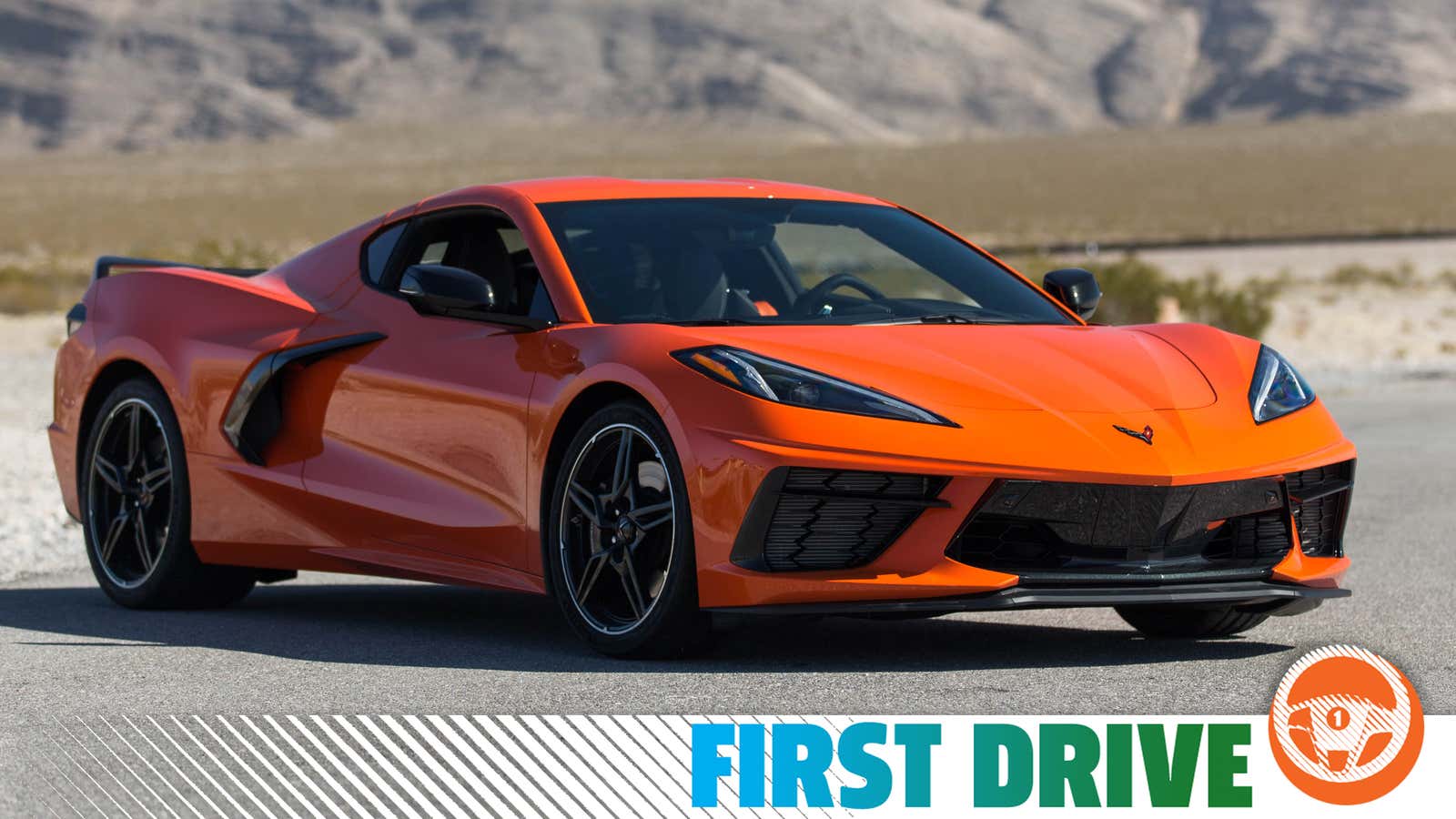I can’t think of a car that has been more hyped, argued, and picked apart than the 2020 Chevrolet Corvette. The C8 Corvette. The mid-engined one. After 60 years of waiting, I sort of expected it to emit a faint glow, perhaps shoot rainbows from its tailpipes. There will be time later for the think pieces and the philosophical debates. For now, here’s what it’s like to drive and what it’s like to (briefly) live with.
When you strip away all the chatter and anticipation, the 2020 Corvette has four wheels, eight cylinders, eight gears, two pedals and two seats. Its engine is mounted between the front and rear axles. It’s a car, like any other, and that necessitates evaluation.
(Full Disclosure: Chevrolet flew me to Vegas, put me up in The Cosmopolitan, wine and dined me continuously and rented out a track at Spring Mountain Motorsports Ranch so I could test out a couple pre-production 2020 Corvettes. I drove the car for an hour and a half on public roads, did about 30 minutes of track driving, had four laps on an autocross course and sat shotgun for two hot laps.)
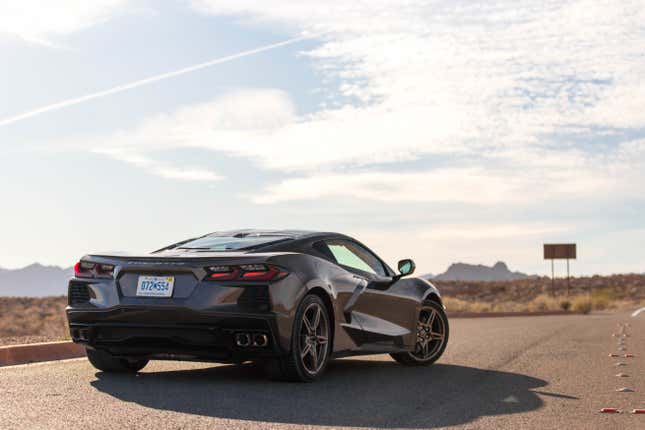
Specs That Matter
For the first time since its inception in 1953, America’s sports car finally has its engine in a true supercar’s position: behind the driver in a midship layout. Not as a concept car. Not as a mule. As a real production model that you or I could buy. Well, if we have around $60,000 to spend.
The C8 Corvette is powered by GM’s LT2 engine; a small-block, 6.2-liter, naturally aspirated V8. It’s good for 495 horsepower and 470 lb-ft of torque. And it comes standard with a dry-sump oil system that has three scavenge pumps. All that means is it’s got race car technology in a street car, the sort of thing that improves track performance without sacrificing street comfort. But it’s largely expensive and difficult to build, so it’s left off more pedestrian cars.
GM claims that the base-model Corvette will spring from zero to 60 mph in an estimated three seconds and do the quarter-mile in 11.2 seconds at 123 mph. When equipped with the Z51 performance package (electronic limited-slip differential, performance exhaust, bigger brakes, track-tuned suspension, front- and rear-spoilers, improved cooling and Michelin Pilot Sport 4S tires) those figures drop to a factory-claimed 2.9 seconds to 60 and an apparent quarter-mile time of 11.2 seconds at 121 mph.
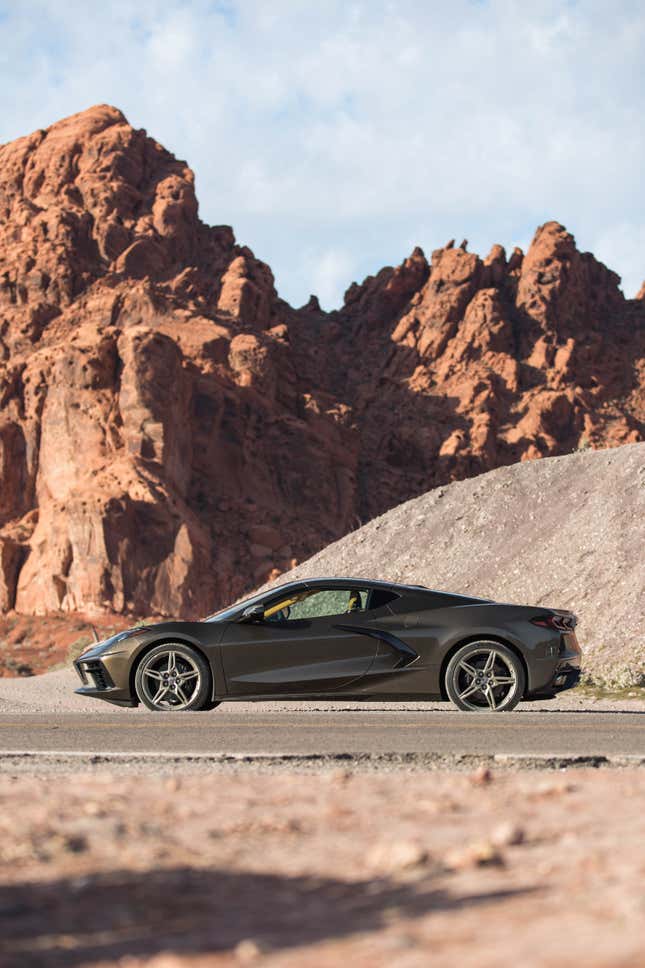
There’s a 40/60 weight distribution, so there’s more weight sitting over the driving wheels now. The car’s engineers say the center of gravity is at the driver’s hip and that the driver sits closer to the front axle of the car. Chevrolet estimates the entry-level model to weigh 3,366 pounds.
During the technical presentation, the Corvette engineers also made it a point to inform everyone the car’s cooling has been validated to 100 degrees Fahrenheit with the air conditioning running and a full tank of gas. I have no idea why this would be something to focus on.
The Good Stuff
The new Corvette has a nice face. It’s pointy and angled and brings to mind the beakiness of a Lamborghini Aventador. While out driving the public road portion of the launch, the car was a utter show stopper. Pedestrians stopped to gawk. Traffic slowed. One guy in an Audi actually stopped in the middle of the road so he could get a picture. I already almost confuse the C7 for something far more exotic when it’s coming at me. The C8 has achieved those supercar looks. Well, in the face, at least.
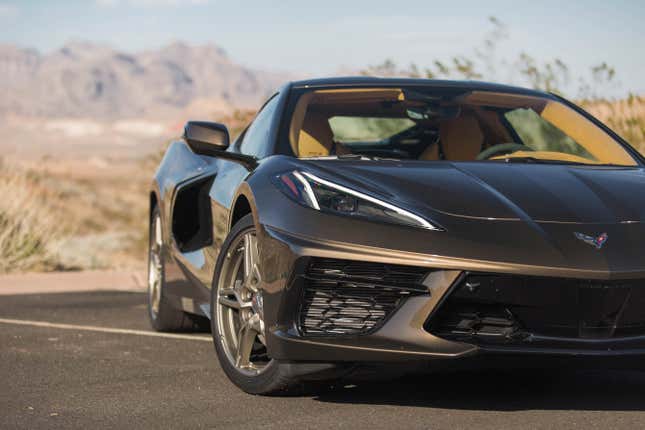
Unfortunately, I found the rest of the car rather ungainly, as if the front half and rear half failed to communicate to each other what the overall aesthetic theme is. The front is all sharp angles and sleekness, the rear is flat rectangles and squares. But anyway. Styling is important, but how the thing drives is what counts.
No matter the speed, the steering remained weighty. This was a nice change from the other cars I’ve been driving, where steering is feather-light at low speeds. The Corvette’s steering-feel is obviously due to electronic witchcraft, since there’s no engine in the nose to cause such resistance. But it isn’t obviously artificial. And it’s very dialed-in because even the lightest touch resulted in a wiggle of the nose. The resulting feedback is communicative. You actually know what those front wheels are doing.

The car I used for the public road drive was not fitted with the magnetic ride suspension system or the Z51 package and, as such, it had a distinctively floaty quality on the highway. Not bouncy, but perhaps more buoyant over the road’s imperfections. It proved extremely comfortable as a long distance cruiser, the sort of car you can get into and just forget about as the miles fall away.
With this setup, though, you can definitely experience the car lean on the track. The center of gravity is low, but you can acutely tell the springs are compressing from the force of the cornering.
The magnetic ride turns the C8 into a different animal. I only got to use it for two laps on the autocross track, but the lean went away and the sensation of driving a car made from one cohesive piece took over. The magnetic ride suspension system is one of the best things GM currently makes, so that’s what I’d spec my Corvette with. The rationale is if the car is already mid-engined, then it should also have all the other athletic features, too.
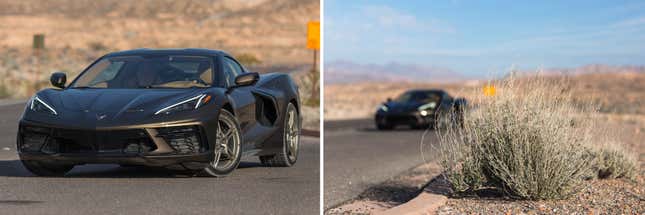
That being said, the mid-engine Corvette does not drive like it is mid-engined. When you get into a midship car, you’re warned about things like snap-oversteer and how balance rests on a knife’s edge. Cars like the Toyota MR2 Turbo. The McLaren 720S. The McLaren 600LT. The Lamborghini Huracán Evo. The Porsche 718 Cayman GTS. You needn’t trouble yourself with such concerns behind the wheel of the C8 (unless you’re really stupid about it). In normal, around-town and highway driving, you’d never know the engine wasn’t in the nose. Sure, the nice V8 noises are coming from right behind your head, but driving it? Feels like a normal car.
Even when I rode shotgun and it was being thrashed around a closed course at Spring Mountain by Mike Petrucci, the Corvette’s Lead Development Engineer, the car did not feel twitchy. Rather, it was planted, predictable and threw out its ass quite happily in a controlled manner. Petrucci later said that was the team’s whole objective when building the C8: to make it easy to drive, daily livable and approachable to anyone.

Petrucci didn’t put the eight-speed, Tremec dual-clutch in manual mode, either. He left it in automatic and let the onboard systems figure it out. Because it’s good. It’s very good. Nowhere in my time with the car did I find myself distracted by transmission hiccups. Automatic transmissions have a very thankless job in this sense. You only notice them when they mess up. The Corvette kept its composure even with mid-corner gear changes, so smooth were the shifts that they surely must have been lubricated by purist tears.
I jest with that last part, because I know how many of you have claimed you wouldn’t even give the C8 a second thought specifically because it has no manual transmission. But as automatics come, this one is pretty damn nice. Even in brief stop-and-go traffic, it didn’t shudder during downshifts. (It does creep forward in first gear). Upshifts come seamlessly and lightning quick. Even manually pulling the paddles kicks the gears down rapidly.
The car is objectively fast, don’t get me wrong. It just doesn’t feel that fast. It’s missing the drama that I enjoy about fast cars. Ear-splitting noise. Violent gearshifts. Hammer-like acceleration. Launch control shoots the C8 forward neatly, every single time, but you never get that extra, animalistic fury I remember so vividly about a V10 BMW M5 or a Jaguar F-Type.
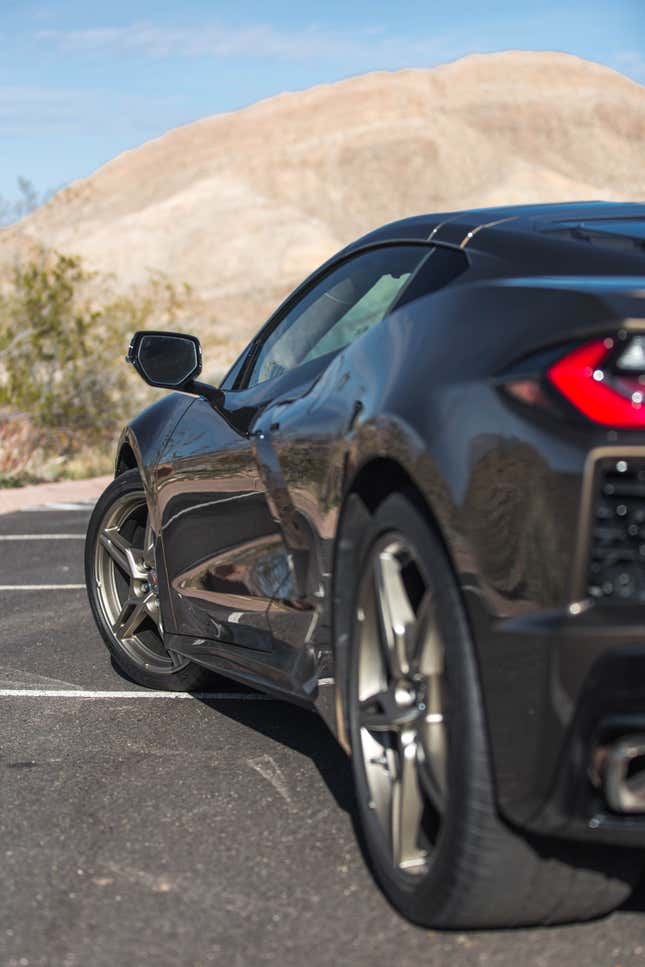
But that’s not what this car is about. This is the reverse of a sleeper. It’s got supercar looks and supercar performance, but docile behavior. It’s not out for blood.
The Not-So-Good Stuff
I never enjoy feeling like I’m being swallowed up by something. The C8's interior did a fine job of reminding me of that. There’s no getting around it, the cabin is cramped. From the passenger seat, I just wasn’t getting as much legroom as I would have liked, and bits of the car just seemed to press in from all sides. The door armrest, center armrest, low ceiling and expansive dashboard cocooned me. Getting into it is like riding in a pod that’s about to be jettisoned from the mothership.
From the driver’s seat, I just couldn’t really see anything. Visibility out the front was fine, I guess, but there was also a vast plain of dash to see over. Side visibility could have been better, since the windows are narrow and the front fenders rise up to block your view.
Thankfully, the wing mirrors are large and stick far out, because you’ll need them. Rear visibility is a joke. You can barely see anything from the little sliver of rear window you’re allotted and the Corvette’s huge rear fenders are difficult to peer around, even with the big wing mirrors. Chevrolet offers a digital rearview mirror, but I found using that dizzying. It always took a second for my eyes to adjust focus each time I used it. Here, the airiness of a Porsche 911's cabin is distinctly absent.
I also suspect the C8 is aimed at physically smaller customers. Ingress and egress isn’t too challenging, but it does take some effort. You swing yourself over the sill and into the low seat (there are a few seat options that range from wider to very extremely bucket-y) and then tuck your knees under the steering wheel.
I had no trouble getting settled, but my driving partner did. He’s about six feet tall and when he tried to adjust the seat and wheel to his driving position, his knees were angled much higher than he was used to. He noted his elbows were always hitting either the center armrest or the bolsters. Two other journalists I chatted with, both men and taller than me, agreed it was difficult to get comfortable. This was not a problem I’d experienced in the Cayman or the Mercedes-AMG GT C.
The driver-centric layout of the interior is very cool, as few cars have such aggressively angled screens and buttons. But it does leave the passenger feeling slightly isolated from the driver. The climate controls are found on that sweeping ridge on the center console, but to the passenger it more realistically forms a wall.
And after fiddling with the climate controls, I can’t say I love the button layout. I’m sure after a while you’ll memorize where everything is, but I found it distracting to use while driving. I’m also not sold on the square steering wheel, either. I like flat-bottom wheels, but the square wheel just seemed like a strange choice. The two-spoke design is nice, however.
Fit, Finish and Usability
Overall, the C8 had decent fit and finish. The doors opened and closed with sonorous clunks, the buttons and switches didn’t feel cheap, the leather and Alcantara was soft to the touch and the strips of aluminum responded solidly if you rapped a knuckle against them. The paddles behind the wheel did not pull flimsily and the infotainment screen and digital dashboard displayed information clearly and intuitively.
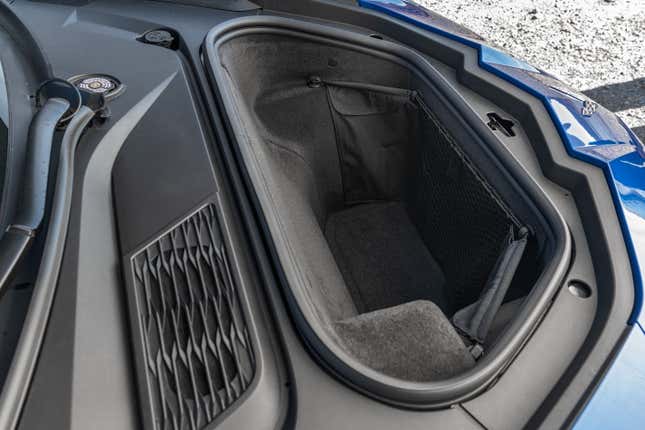
Storage space is also decent! The frunk appears a bit smaller than a 911's, but you could still get a carry-on suitcase in there. The trunk will certainly fit golf clubs if you’re into that (indeed, that’s probably what dictated the C8's squashed rear), and also a good amount of groceries.
Be warned, though: The trunk gets hot. So maybe be mindful about where you put the ice cream.
Early Verdict
It is obvious to me the C8 Corvette is aimed at a younger buyer. Its engineers took risks in the interior layout and it definitely seems cabin space has a specifically sized human in mind. If they truly wanted to keep existing buyers, they would not have altered the interior so radically. Whether or not The Youths actually wind up buying this car remains to be seen.
And despite it being mid-engined, it certainly doesn’t feel mid-engined in that it doesn’t have the impish, petite and dancer-like feel of a Porsche 718 or BMW i8. Those cars fit around you like a glove. You wear them more than you drive them. Even in the autocross course, which the C8 handled extremely well, you’re still very aware there’s a big car around you. You feel the weight, you’re mindful of its dimensions. Those thoughts never really go away.
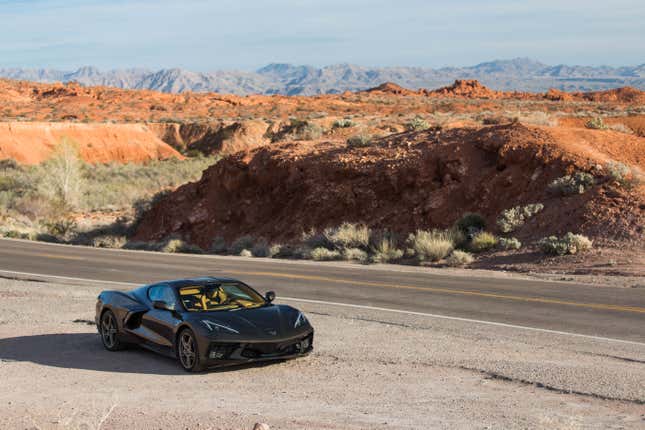
No, the mid-engine Corvette’s biggest draw is that it is the mid-engine Corvette. The thing the legends have whispered of for so long, finally real, finally corporeal. But driving it? Feels like a sports car that does the daily stuff well and the track stuff well also. Could be faster. Could be louder. Could be harder. Won’t fatigue you on the highways.
This is almost definitely by design of course. Chevrolet can’t go so big, so fast so soon with the C8 Corvette, not if it also wants to launch performance versions such as the Z06 and ZR1 replacements later on. Nothing’s been confirmed, of course, and not one Chevrolet spokesperson would speak about future plans, but come on. This is but the base Corvette. Bigger and badder ones are coming.
There’s also the idea that Chevrolet could be finding a more mass-market balance—meaning the C8 is meant to be an approachable, mass-appeal sports car. It has usable trunks, it’s great at cruising and it’s fast. I just didn’t find it particularly joyous. Most mid-engine cars, certainly many of the cars you might consider rivals to the Corvette, feel dangerous, thrilling, nervous, and edgy. The Corvette wasn’t like that. It wasn’t extra. It felt like a car doing the car things it was supposed to do. Nothing more and nothing less.
